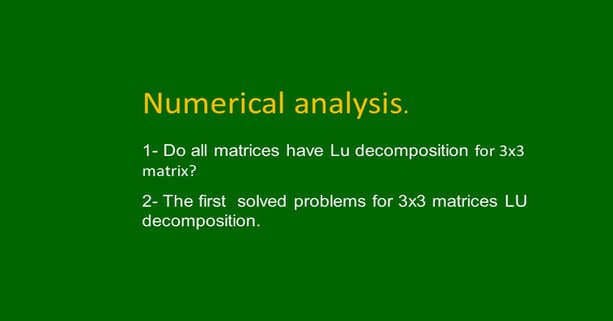Last Updated on March 21, 2024 by Maged kamel
First solved problem-LU decomposition for the 3×3 matrix.
For the First solved problem-LU decomposition, check that the given matrix is invertible
First I will refer to one of the math sites which is, HELM, which is the abbreviation for helping engineers learn mathematics, there is a valuable source HELM, please refer to Item# 30. Introduction to Numerical Methods, article 30.3, from which I have used the information to create this post.
Start with the first question, do all matrices have an LU decomposition? The answer is sometimes it is not possible to write the matrix in the form of a Lower triangular multiplied by the Upper triangular. Why not?
An invertible matrix has an LU decomposition provided that all the leading submatrices have non-zero determinants.
We will move to the second slide, to apply this statement.
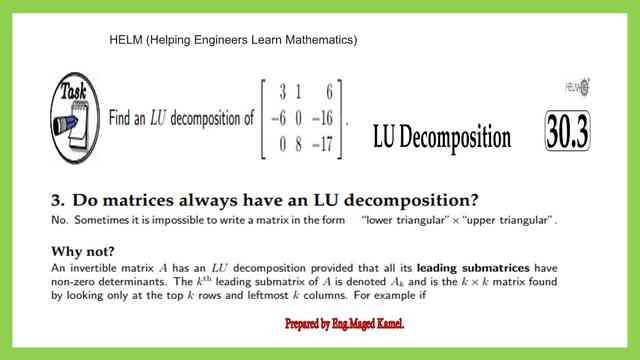
We check the submatrices determinants to be nonzeros, as follows: the first submatrix is A1 which is the corner element of the matrix simply a11, it has a value of 3 which is not a zero value. The second submatrix is A2, which is a matrix of 2×2, elements are( 3 1 -6 0) the determinant value is not zero it equals +6.
The value of sub-matrices should be non-zero to check that the matrix will have Lu decomposition.
Finally, the entire matrix which is called A3 is a determinant is -6 not zero. Since all the submatrices have fulfilled the requirements, then the given matrix can have LU decomposition.

Step-1-Develop an expression for U1 and L1 matrices.
We will proceed to estimate L and U matrices for the given 3×3 matrix. For the lower matrix L by definition, we have L11=L22=L33=1, then it is required to find the values of L21 and L31.
L21=a21/a11 while L31=a31/a11, consider a11 as a pivot. We can see the two arrows going from -6 to 3 will give -3 for L21 and the second arrow from 0 to 3, then l31= 0/3.
The next step is to apply Gauss elimination to get the upper matrix U1. Multiply the value of L21*(-1)R1 and add it to the second Row.
Multiply the value of L31*(-1)R1 and add it to the third Row. We can see the matrix u1 as a 3×3 matrix that has the first row of (3 1 16 ) which is identical to the first row of the original matrix. The second row is ( 0 2 -4). The
The third row is (0 8 -17).
The next step is to find L32 which is the last unknown for the lower matrix L.
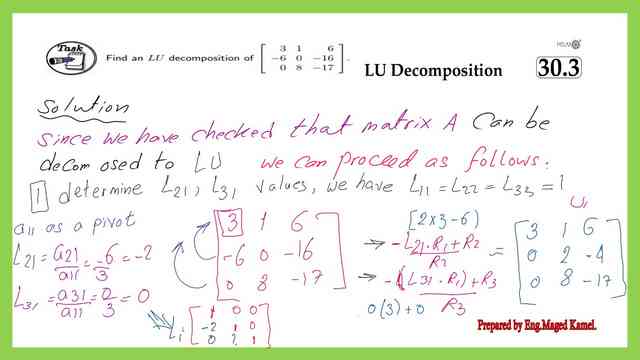
Step-2-Derive the expression for the final U and L matrices.
From the previous slide, we have U1, consider a22 as a pivot, and divide a32/a22 to get the value of l32, check the arrow which goes from 8 to 2, the division of 8/2 is equal to 4 which is the value of L32.
Now we have completed the elements of the lower matrix. These elements are ( 1 0 0, -2 1 0, 0 4 1).
We proceed to find the final upper matrix, multiply -l32*R2 and add it to R3, then we multiply -4 by the second row of the U1 matrix and add the value to the third row. The final Upper matrix is ( 3 1 6, 0 2 4, 0 0 -1).
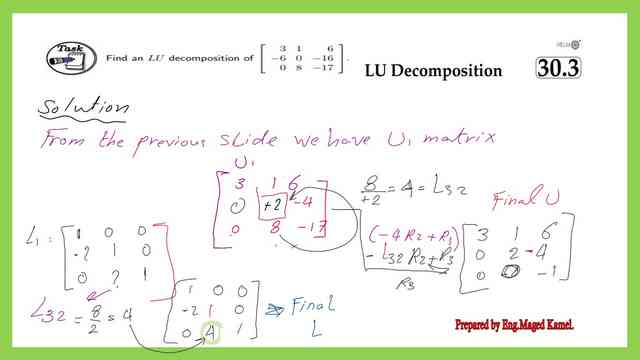
Step-3-Check LU=A for the 3×3 matrix.
Now, we would like to check the expression of L*U=A. We will perform row-column operations of the multiplication of L by U matrices.
We multiply row 1 by column 1 (1 0 0 ) by (3 0 0) will give the value of 3 this is a11.
We multiply row 1 by column 2 (1 0 0 ) by (1 2 0) will give the value of 1 which is a12. We multiply row 1 by column 3 (1 0 0 ) by (6 -4 -1) will give the value of 6 which is a13. We multiply row 2 by column 1 (-2 1 0 ) by (3 0 0) will give the value of -6 this is a21. We multiply row 2 by column 2 (-2 1 0 ) by (1 2 0) will give the value of 0 which is a22.
We multiply row 2 by column 3 (-2 1 0 ) by (6 -4 -1) will give the value of -16 which is a23.
We multiply row 3 by column 1 ( 0 4 1) by (3 0 0) will give the value of 0 this is a31. We multiply row 3 by column 2 ( 0 4 1) by (1 2 0) will give the value of 8 which is a32.
Finally, we multiply row 3 by column 3 ( 0 4 1) by (6 -4 -1) will give the value of -17 which is a33. The final Upper matrix is ( 3 1 6, 0 2 4, 0 0 -1).
The matrix A can be set to be the product (L*U). A routine check of the product of L*U will produce the same elements of matrix A to be performed.
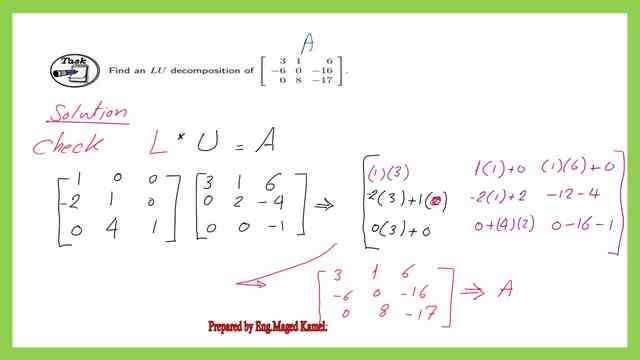
This is the pdf file used for the illustration of this post and the next post.
This is the next post: The Second solved problem– LU decomposition for the 3×3 matrix.
HELM-Helping Engineers Learn Mathematics.
This is the Omni calculator for estimating various items of linear algebra -LU Decomposition Calculator.
This is a link to another –Calculator for matrices.

